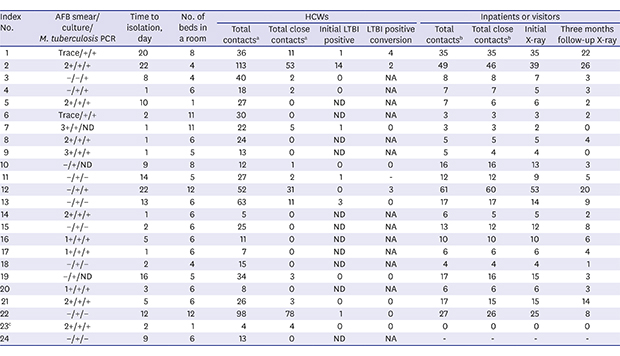2. World Health Organization. Global Tuberculosis Report 2017. Geneva: World Health Organization;2017.
3. Korea Centers for Diseases Control and Prevention. 2017 Annual Report on the Notified Tuberculosis in Korea. Cheongju: Korea Centers for Diseases Control and Prevention;2018.
4. Jarvis WR. Mycobacterium tuberculosis. In : Mayhall CG, editor. Hospital Epidemiology and Infection Control. Riverwoods, IL: Wolters Kluwer Health;2011.
5. Lee JE, Kim YK, Kim TH, Kim KH, Lee EJ, Uh ST, et al. What strategy can be applied to the patients with culture positive tuberculosis to reduce treatment delay in a private tertiary healthcare center? Infect Chemother. 2011; 43(1):42–47.

6. National Tuberculosis Controllers Association. Centers for Disease Control and Prevention (CDC). Guidelines for the investigation of contacts of persons with infectious tuberculosis. Recommendations from the National Tuberculosis Controllers Association and CDC. MMWR Recomm Rep. 2005; 54(RR-15):1–47.
7. National Institute for Health and Care Excellence. Tuberculosis: clinical diagnosis and management of tuberculosis, and measures for its prevention and control. Updated 2016. Accessed October 17, 2017.
http://www.nice.org.uk/guidance/ng33.
8. Erkens CG, Kamphorst M, Abubakar I, Bothamley GH, Chemtob D, Haas W, et al. Tuberculosis contact investigation in low prevalence countries: a European consensus. Eur Respir J. 2010; 36(4):925–949.


9. Lee SW, Oh DK, Lee SH, Kang HY, Lee CT, Yim JJ. Time interval to conversion of interferon-gamma release assay after exposure to tuberculosis. Eur Respir J. 2011; 37(6):1447–1452.

10. Menzies D. Interpretation of repeated tuberculin tests. Boosting, conversion, and reversion. Am J Respir Crit Care Med. 1999; 159(1):15–21.

11. Khanna P, Nikolayevskyy V, Warburton F, Dobson E, Drobniewski F. Rate of latent tuberculosis infection detected by occupational health screening of nurses new to a London teaching hospital. Infect Control Hosp Epidemiol. 2009; 30(6):581–584.


12. Lee K, Han MK, Choi HR, Choi CM, Oh YM, Lee SD, et al. Annual incidence of latent tuberculosis infection among newly employed nurses at a tertiary care university hospital. Infect Control Hosp Epidemiol. 2009; 30(12):1218–1222.


13. Park HY, Jeon K, Suh GY, Kwon OJ, Chung DR, Yoonchang SW, et al. Interferon-γ release assay for tuberculosis screening of healthcare workers at a Korean tertiary hospital. Scand J Infect Dis. 2010; 42(11-12):943–945.


15. Greenaway C, Menzies D, Fanning A, Grewal R, Yuan L, FitzGerald JM, et al. Delay in diagnosis among hospitalized patients with active tuberculosis--predictors and outcomes. Am J Respir Crit Care Med. 2002; 165(7):927–933.


17. Kim SY, Park MS, Kim YS, Kim SK, Chang J, Yong D, et al. Tuberculin skin test and boosted reactions among newly employed healthcare workers: an observational study. PLoS One. 2013; 8(5):e64563.







 PDF
PDF Citation
Citation Print
Print




 XML Download
XML Download